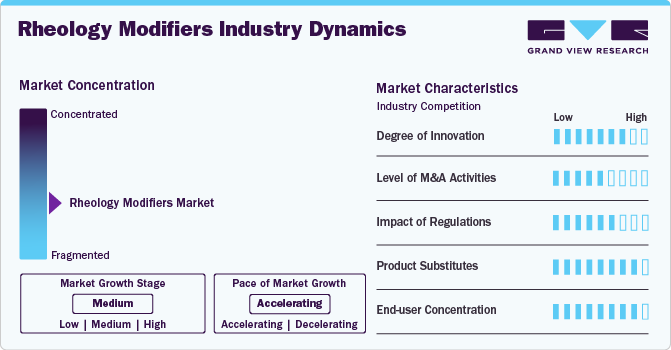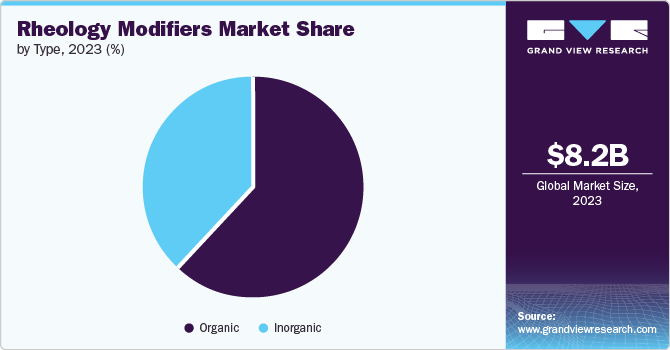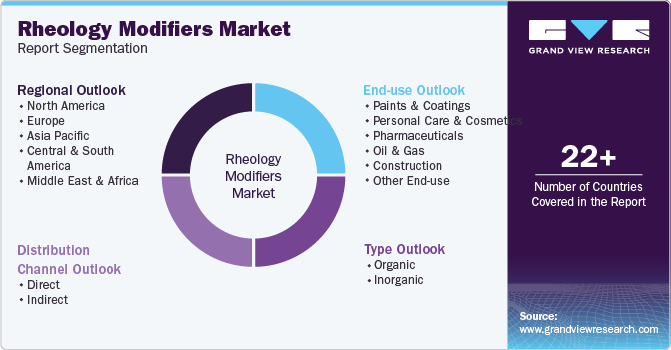- Home
- »
- Personal Care & Cosmetics
- »
-
Rheology Modifiers Market Size, Share, Growth Report, 2030GVR Report cover
![Rheology Modifiers Market Size, Share & Trends Report]()
Rheology Modifiers Market Size, Share & Trends Analysis Report By Type (Organic, Inorganic), By Distribution Channel (Direct, Indirect), By End-use (Paints & Coatings, Oil & Gas), By Region, And Segment Forecasts, 2024 - 2030
- Report ID: GVR-4-68040-347-6
- Number of Report Pages: 120
- Format: PDF, Horizon Databook
- Historical Range: 2018 - 2023
- Forecast Period: 2024 - 2030
- Industry: Bulk Chemicals
Rheology Modifiers Market Size & Trends
The global rheology modifiers market size was estimated at USD 8.24 billion in 2023 and is expected to grow at a CAGR of 4.2% from 2024 to 2030. Growing demand for the product from paints & coatings and personal care & cosmetics coupled with a surge in shale gas exploration and crude oil production is anticipated to contribute to the market growth in the near future.

Rheology is the direct relationship between the stress and strain of the substance. It assists in understanding the mechanical behavior of the substances with the surfaces. For several applications in key sectors, such as paints, food and beverage, pharmaceuticals, inks, cosmetics, oil, and coatings, viscosity is a vital rheological parameter.
Rheology modifiers are additives utilized in most industries to manage behaviors like shear thickening or thinning and to change the viscosity magnitude. These vital ingredients can assist in ease of application, control texture, shelf stability, and processability, and help attain the proper viscosity. Growing utilization of rheology modifiers, including K-carrageenan, arginine, laponite, and xanthan gum, to name a few, is predicted to drive market growth over the forecast period.
Market Concentration & Characteristics
The market is fragmented owing to the high availability of organic and inorganic rheology modifier producers, with key players obtaining less than 80% of the market's share. Market leaders are heavily investing in research and development activities to expand their product portfolio and gain a higher share of the market.

In this highly competitive market, the players must offer cost-effective solutions to sustain themselves in the long term. The industry participants are also undertaking strategic initiatives such as contractual agreements, novel product launches, collaboration, and investments to expand their footprint globally.
End Use Insights
Paints & coatings dominated the market with a revenue share of 35.7% in 2023. This is attributable to the increasing usage of the products to control the flow behavior and viscosity of the paints, prevent pigments from settling, and augment the overall appearance and performance of coatings. The surge in the application of paints & coatings in commercial and residential construction, especially in developing economies, is anticipated to trigger the product demand for the paints & coatings formulations.
Personal care and cosmetics emerged as the fastest-growing segment, owing to the inclusion of rheology modifiers as thickeners in the formulation of skin care creams, makeup, toiletry products, and foundation. Developing nations such as China, India, and Russia offer high potential for foreign companies that offer superior quality compared to local producers.
Distribution Channel Insights
Indirect channel dominated the market with a revenue share of 58.9% in 2023. This is attributed to the preference of end users for retailers, wholesalers, and exporters. The widespread availability of rheology modifiers in the industry and the high penetration of end users have prompted manufacturers to sell their products through indirect channels.
The direct channel is anticipated to witness high demand in the near future due to a surge in local production and supply. The direct supply of the modifiers to the consumers has resulted in lower prices and higher demand on a regional level, which is further estimated to contribute to the direct supply of the product over the forecast period.
Type Insights
The organic type dominated the market with a revenue share of 62.3% in 2023. This is attributed to diversity in terms of availability and chemistry compared to the inorganic type. The product's environmentally friendly nature and high performance have been attributed to its demand over the past decade.

Inorganic rheology modifiers are mineral-based materials, including silica, clay, and talc, among other minerals. These types of modifiers are known for their shear-thinning and thixotropic behavior. The inorganic types are widely preferred in drilling fluids, paints & coatings, and formulation of personal care products.
Regional Insights
U.S. Rheology Modifiers Market Trends
The U.S. emerged as the leading consumer in the North America region. The country is considered to be an investment hub by international players due to the presence of natural resource reserves in the country. The manufacturers in the U.S. are engaged in expansions and technological advances to cater to the product demand from end use industries such as pharmaceuticals and personal care & cosmetics industry.
Asia Pacific Rheology Modifiers Market Trends
Asia Pacific dominated the market with a revenue share of 34.8% in 2023. The growing infrastructural projects and population in the region, followed by high investments in oil & gas, construction, and power generation industry, have contributed to the market growth. In addition, the growing consumer demand for enhancing sensory experience from the personal care & cosmetics industry is expected to boost the market growth in the Asia Pacific region, especially in China, India, South Korea, and Japan, to name a few.

India Rheology Modifiers Market Trends
India rheology modifiers market is anticipated to grow at a notable CAGR, owing to the growth in the additives industry. The focus of the Indian government on higher investments and expenditure has estimated the chemical industry to grow to USD 300 billion by the end of 2025. The growth in additive manufacturing and integration towards natural/synthetic feedstock is anticipated to contribute to the market growth in the near future.
Saudi Arabia Rheology Modifiers Market Trends
Saudi Arabia is a key consumer of rheology modifiers in the Middle East & Africa region, owing to the dominant oil & gas industry. The upcoming investment projects in the country, especially in Riyadh, are anticipated to turn a higher share of their crude oil into chemicals. A joint development agreement by Total and Saudi Aramco for a giant petrochemical complex is scheduled to start in 2024. The investment is an estimate of USD 5 billion; wherein the plant shall provide feedstock to specialty chemicals and petrochemicals plants in Jubail industrial area.
Brazil Rheology Modifiers Market Trends
The use of coatings on public murals and artistic surfaces highlights Brazil government’s efforts for preserving cultural assets. In addition, the country's focus on sustainable and environmentally friendly coatings has contributed to the development of advanced solutions, driving the market's growth and technological innovations.
Key Rheology Modifiers Company Insights
The global rheology modifiers industry is fragmented due to the wide presence of manufacturing across the globe. The players are engaged in mergers and acquisitions and new product launches to dominate the market. For instance, in April 2021, Clariant AG acquired a Switzerland-based company, Polygal AG, to elevate the natural rheology modifiers brand for coatings and personal care applications.
BASF SE, The Dow Chemical Company, Lubrizol Corporation, Clariant, Ashland, Akzo Nobel N.V., and Cargill Incorporated are some of the leading market participants in the market.
-
BASF SE: BASF SE offers a broad range of additives for agriculture, automotive & transportation, chemicals, coatings, construction, electronics, energy, cleaning, nutrition, and pharmaceutical industries, to name a few. The company provides rheology modifiers under the “Performance & Formulation Additives” domain for the construction industry
-
Cargill Incorporated: Cargill Incorporated offers numerous products and services to animal nutrition, agriculture, beauty, bioindustrial, food & beverages, industrial, and pharmaceutical, among others. The company offers rheology modifiers under the bioindustrial domain
Elementis Plc., BYK Additives & Instruments, Wacker Chemie AG, and Innospec Inc. are some of the emerging market participants.
-
Wacker Chemie AG: Wacker Chemie AG offers numerous products such as amino acids, polysilicon, silicone rubber, polymer dispersions, and fine chemicals, among others. The company provides rheology modifiers for architectural coating applications
-
BYK Additives & Instruments: BYK Additives & Instruments is a key provider of specialty chemicals, innovative additives like rheology modifiers, and solutions. The company operates through its production facilities and subsidiaries in the Netherlands, Germany, the U.S., the UK, and China
Key Rheology Modifiers Companies:
The following are the leading companies in the rheology modifiers market. These companies collectively hold the largest market share and dictate industry trends.
- BASF SE
- The Dow Chemical Company
- Lubrizol Corporation
- Clariant
- Arkema
- Ashland
- Akzo Nobel N.V.
- Elementis Plc.
- BYK Additives & Instruments
- Cargill Incorporated
- DuPont
- Evonik Industries AG
- PPG Industries
Recent Developments
-
In February 2024, AkzoNobel N.V. completed the expansion of its coatings manufacturing facility in Como, Italy, at a cost of USD 22.7 million. The four new manufacturing lines would produce architectural coatings and automotive primers, increasing the company’s capacity to serve customers across Eastern Europe.
- In February 2023, Cargill Incorporated discovered a novel brand of rheology modifier, “Aristoflex Eco T,” in the market, which provides cosmetic formulators to produce luxurious products without compromising biodegradabilit
Rheology Modifiers Market Report Scope
Report Attribute
Details
Market size value in 2024
USD 8.52 billion
Revenue forecast in 2030
USD 10.91 billion
Growth Rate
CAGR of 4.2% from 2024 to 2030
Historical data
2018 - 2023
Forecast period
2024 - 2030
Quantitative units
Volume in kilotons, revenue in USD million and CAGR from 2024 to 2030
Report coverage
Volume & revenue forecast, company ranking, competitive landscape, growth factors, and trends
Segments covered
Type, end use, distribution channel, region
Regional scope
North America, Europe, Asia Pacific, Central & South America, Middle East & Africa
Country scope
U.S., Mexico, Canada, Germany, UK, France, Italy, Spain, China, Japan, India, South Korea, Brazil, Argentina, South Africa, Saudi Arabia
Key companies profiled
BASF SE, The Dow Chemical Company, Lubrizol Corporation, Clariant, Arkema, Ashland, Akzo Nobel N.V., Elementis Plc., BYK Additives & Instruments, Cargill Incorporated, DuPont, Evonik Industries AG, PPG Industries
Customization scope
Free report customization (equivalent up to 8 analysts working days) with purchase. Addition or alteration to country, regional & segment scope.
Pricing and purchase options
Avail customized purchase options to meet your exact research needs. Explore purchase options.
Global Rheology Modifiers Market Report Segmentation
This report forecasts revenue & volume growth at global, regional, and country levels and provides an analysis of the latest industry trends in each of the sub-segments from 2018 to 2030. For this study, Grand View Research has segmented the global rheology modifiers market report based on type, end use, distribution channel, and region:

-
Type Outlook (Volume, Kilotons; Revenue, USD Million, 2018 - 2030)
-
Organic
-
Inorganic
-
-
End Use Outlook (Volume, Kilotons; Revenue, USD Million, 2018 - 2030)
-
Paints & Coatings
-
Personal Care & Cosmetics
-
Pharmaceuticals
-
Oil & Gas
-
Construction
-
Other End Use
-
-
Distribution Channel Outlook (Volume, Kilotons; Revenue, USD Million, 2018 - 2030)
-
Direct
-
Indirect
-
-
Regional Outlook (Volume, Kilotons; Revenue, USD Million, 2018 - 2030)
-
North America
-
U.S.
-
Mexico
-
Canada
-
-
Europe
-
Germany
-
UK
-
France
-
Italy
-
Spain
-
-
Asia Pacific
-
China
-
Japan
-
India
-
South Korea
-
-
Central & South America
-
Brazil
-
Argentina
-
-
Middle East and Africa
-
South Africa
-
Saudi Arabia
-
-
Frequently Asked Questions About This Report
b. The global rheology modifiers market size was estimated at USD 8.24 billion in 2023 and is expected to reach USD 8.52 billion in 2024.
b. The global rheology modifiers market is expected to grow at a compound annual growth rate of 4.2% from 2024 to 2030 to reach USD 10.91 billion by 2030.
b. Asia Pacific dominated the rheology modifiers market with a share of 34.8% in 2023. The growing infrastructural projects and population in the region, followed by high investments in oil & gas, construction, and power generation industry, has contributed to the market growth.
b. Some key players operating in the rheology modifiers market include BASF SE, The Dow Chemical Company, Lubrizol Corporation, Clariant, Arkema, Ashland, Akzo Nobel N.V., Elementis Plc., BYK Additives & Instruments, Cargill Incorporated, DuPont, Evonik Industries AG, PPG Industries.
b. Key factors that are driving the market growth include growing demand for the product from paints & coatings and personal care & cosmetics coupled with a surge in shale gas exploration and crude oil production.
Share this report with your colleague or friend.
![gvr icn]()
NEED A CUSTOM REPORT?
We can customize every report - free of charge - including purchasing stand-alone sections or country-level reports, as well as offer affordable discounts for start-ups & universities. Contact us now
![Certified Icon]()
We are GDPR and CCPA compliant! Your transaction & personal information is safe and secure. For more details, please read our privacy policy.
We are committed towards customer satisfaction, and quality service.
"The quality of research they have done for us has been excellent."





